Ditch The Toxic Ingredients: Make Your Own Natural Deodorant
If you are using commercial shampoos, conditioners, body soaps, body lotions, tooth pastes, facial soaps, and deodorants regularly, the chances are that you are not as “clean” as you think you are.
You may smell great and be bacteria free, but your body is probably chock full of harmful ingredients that are deemed not very “clean” by environmental watch groups.
Some ingredients found in personal care products have been linked to rising rates in breast cancer, asthma, reproductive issues, and other health problems.
Start By Reading Labels
To know what goes into your products, you will need to read the back label of each and every item you purchase. Labels also don't always disclose every ingredient in your products, but tools like the Think Dirty App or Household Products Database can help provide you with more insight.
Although the presonal care industry is not well-regulated and has been slow to test ingredients for safety, there are ten substances now known to be unsafe for long term daily use. These chemical toxins may accumulate in your body and interact in potentially harmful ways.
10 Toxic Chemicals to avoid in your personal care products
Parabens (methyl- & propyl-, butyl-, ethyl-)
Formaldehyde & Formaldehyde Releasing Chemicals
Parfum/Fragrances (Artificial/Natural)
Phthalates
TALC
Triclosan
Oxybenzone/Benzophenone-3
Coal Tar and Coal Tar Dyes (crude & refined)
Hydroquinone
Synthetic phenolic antioxidant compounds (SPAs) or BHA & BHT
Making the Switch: Start with Your Antiperspirant
Since we all tend to wear deodorant or antiperspirants daily (sometimes multiple times a day) it is a good idea to start here.
Most commercial antiperspirants contain Parabens, Triclosan, Pthalates, Fragrances, and Aluminum, which are all ingredients that have been found to cause hormone disruption and could cause or contribute to developmental or reproductive problems, as well as cancer, according to the National Cancer Institute.
Antiperspirants can even affect your body’s sensitve microbiome, according to this study.
One way you can circumvent this problem is to make some of your own personal care products. Continue reading below for my tried-and-tested natural deodorant recipe.
Natural Deodorant Recipe
I usually increase the ratios to mix large batches of the following ingredients over a double boiler to melt the ingredients and make mixing easier.
What You’ll Need to Fill an 6oz Mason jar:
1.5 Tablespoons beef tallow
1 Tablespoon unrefined coconut oil (you can skip this oil and increase the tallow or shae butter if you are allergic to tree nuts)
1 Tablespoon unrefined shea butter
1 Tablespoon arrowroot starch/flour
4.5 Teaspoons baking soda
2-3 drops of lavender essential oil OR 2-3 drops of tea tree peppermint essential oil
I start by melting down my coconut and shae butter together, then mixing in the arrowroot starch (you can use corn starch instead, if that’s what you prefer) and baking soda.
Finally I add a few drops of my favorite essential oils. Lavendar, Tea Tree, or Ylang Ylang are some of my favorites.
I usually keep my deodorant in the fridge, as I like a harder consistency before applying with a bamboo spatuala. Others like to keep theirs in the bathroom to keep it runny and apply with their fingers.
You May Need Time to Get Used to It
This natural deodorant may need a few applications throughout the day to work most effectively, but in my experience I find that it holds up for most of my workouts or yoga sessions.
If you have been using commercial products for years, you may need to give your armpits and body some time to adapt to this recipe. The bacteria found in our armpits change with antiperspirant use and so you may need to give your body time to detox and adapt to natural deodorants.
Be sure to let me know how it goes for you, in the comments below. Let me know whether the recipe was easy to follow, or whether it held up well for you.


